1. Overview of Kim Giao Forest
Located within Cat Ba National Park, Kim Giao Forest is part of one of the world’s largest biosphere reserves, covering an impressive 17,362 hectares. This lush forest is home to an incredibly diverse ecosystem, including pristine rainforests, mysterious limestone caves and stunning coastal scenery. According to scientific research, Cat Ba’s flora is extremely rich, with more than 1,561 species of higher plants, belonging to 842 genera and 186 families. Among them, Kim Giao forest stands out with precious wood species such as Kim Giao, Xa Den, Bo Cot Toai, Bach Nhat all of which are highly valued for their ecological and medicinal values. The forest is also home to 343 species of wildlife, including the Cat Ba langur, an endemic, rare and endangered primate listed in the Vietnam Red Book.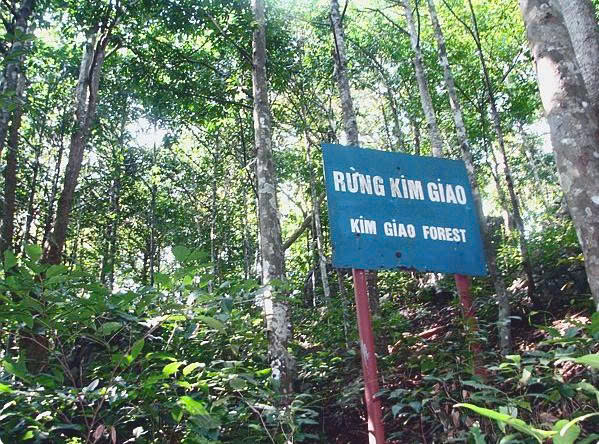 In addition to its biological significance, Kim Giao Forest is located in an area rich in historical tradition. Archaeological discoveries in Cat Ba dating back between 9,000 and 17,000 years have revealed traces of early human civilization at sites such as Cai Beo, Bai Ben and Hang Doi, making the area not only a natural wonder but also a cultural treasure.
Today, visitors can explore Kim Giao Forest as part of the Cat Ba National Park ecotourism route, which includes botanical gardens, caves and educational routes. Among them, the Kim Giao Forest – Ngu Lam Peak route remains the top choice for visitors who want to hike to explore the spectacular landscape and get closer to nature.
In addition to its biological significance, Kim Giao Forest is located in an area rich in historical tradition. Archaeological discoveries in Cat Ba dating back between 9,000 and 17,000 years have revealed traces of early human civilization at sites such as Cai Beo, Bai Ben and Hang Doi, making the area not only a natural wonder but also a cultural treasure.
Today, visitors can explore Kim Giao Forest as part of the Cat Ba National Park ecotourism route, which includes botanical gardens, caves and educational routes. Among them, the Kim Giao Forest – Ngu Lam Peak route remains the top choice for visitors who want to hike to explore the spectacular landscape and get closer to nature.
2. Legend of Kim Giao Forest
Amidst the wild beauty of Cat Ba National Park, Kim Giao Forest is not only a natural wonder but also a land associated with legends and love. According to local legend, the name “Kim Giao” originates from the tragic but immortal love story between Princess Kim Ngan, a beautiful woman, and General Ngoc Giao, a talented and kind warrior. Because they were prevented from being together, the lovers chose to transform into forest trees so that their souls could be together forever. Since then, the forest has been called Kim Giao, a symbol of faithful and immortal love, passed down through generations of Cat Ba people. More than just a legend, the Kim Giao tree holds a special place in Vietnamese history. Its wood was once used to make chopsticks for kings, as ancient people believed it had the ability to detect poison changing color or showing unusual signs when exposed to toxins. This belief has turned the Kim Giao forest into a sacred space, where nature, culture and tradition intersect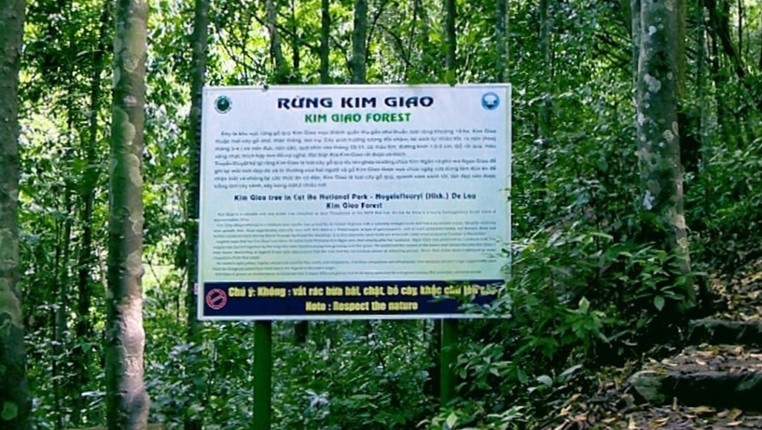 Today, as you walk beneath the emerald green canopy, you can almost hear the whispers of fairy tales carried by the wind. The legend of Kim Ngan and Ngoc Giao has breathed life into Kim Giao Forest transforming it from a simple trekking trail into a vivid story of love, heritage and harmony with nature.
For those seeking more than a beach holiday, this mystical forest offers a deeper connection to the cultural and ecological richness of Cat Ba Island.
Today, as you walk beneath the emerald green canopy, you can almost hear the whispers of fairy tales carried by the wind. The legend of Kim Ngan and Ngoc Giao has breathed life into Kim Giao Forest transforming it from a simple trekking trail into a vivid story of love, heritage and harmony with nature.
For those seeking more than a beach holiday, this mystical forest offers a deeper connection to the cultural and ecological richness of Cat Ba Island.
3. Kim Giao Forest Hike: The Journey to Ngu Lam Peak
Exploring Kim Giao Forest and conquering Ngu Lam Peak is one of the most rewarding experiences inside Cat Ba National Park. The entire hiking route is about 3 kilometers long and takes around 2 to 3 hours to complete.3.1. Starting from Cat Ba National Park Center
Your adventure begins at the Cat Ba National Park Center, where a paved trail stretches for nearly one kilometer before leading you to the foot of the mountain. This initial walk is gentle and refreshing, surrounded by the dense green canopy of the tropical forest. Along the way, you’ll spot a variety of rare plants such as Hopea odorata, Terminalia catappa, Bo tree, and Erythrophleum fordii, each adding to the natural richness of the park.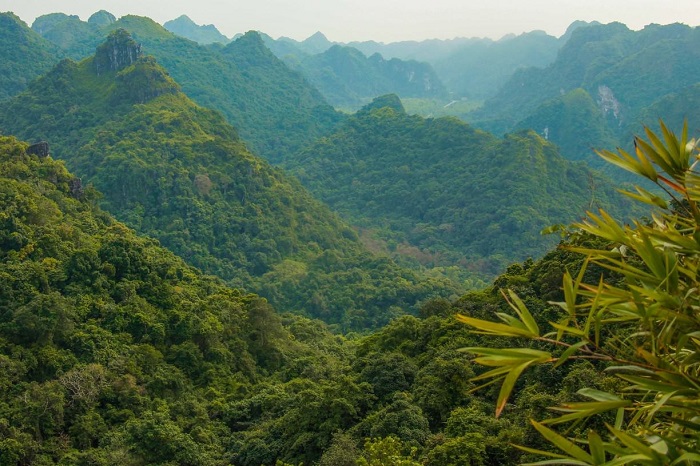 Hidden among the dense foliage are a few old, deserted houses, once used as ranger shelters, now covered in moss and vines. These quiet, mysterious remnants of the past add a fascinating touch to your journey, making you feel like you are stepping into a forgotten world. From here, the real adventure begins with a trek through Kim Giao Forest, the green heart of Cat Ba.
Hidden among the dense foliage are a few old, deserted houses, once used as ranger shelters, now covered in moss and vines. These quiet, mysterious remnants of the past add a fascinating touch to your journey, making you feel like you are stepping into a forgotten world. From here, the real adventure begins with a trek through Kim Giao Forest, the green heart of Cat Ba.
3.2. Entering the Kim Giao Forest
Continuing the journey, you will follow a narrow 500-meter-long trail that winds through steep slopes (up to 40-50 degrees) and sharp limestone cliffs. Although challenging, you will enjoy the fresh air, chirping birds and the rustling of the forest canopy above. At an altitude of about 150 meters above sea level, the landscape suddenly opens up before your eyes: the majestic Kim Giao forest, which covers nearly 10 hectares. The name of the forest comes from the Kim Giao tree (Nageia Fleuryi), a rare species found only in this area.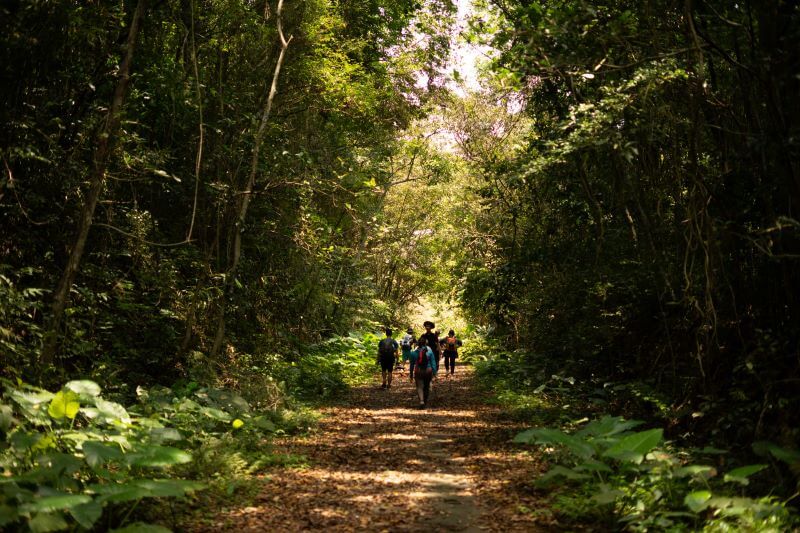 With tall, straight trunks and pyramid-shaped foliage, these trees form a lush green cathedral reaching high into the sky. Their strong roots cling tightly to the rocky ground, absorbing nutrients from deep within the ground, symbolizing perseverance and harmony with nature.
If you visit between June and July, you will see the Kim Giao tree in bloom, with its delicate white flowers glowing against an emerald background, a mesmerizing sight perfect for nature lovers and photographers.
With tall, straight trunks and pyramid-shaped foliage, these trees form a lush green cathedral reaching high into the sky. Their strong roots cling tightly to the rocky ground, absorbing nutrients from deep within the ground, symbolizing perseverance and harmony with nature.
If you visit between June and July, you will see the Kim Giao tree in bloom, with its delicate white flowers glowing against an emerald background, a mesmerizing sight perfect for nature lovers and photographers.
3.3. Conquering Ngu Lam Peak
After soaking in the tranquil beauty of the Kim Giao forest, it’s time to make the final climb another 500 metres to Ngu Lam peak, 225 metres above sea level. The climb gets steeper and steeper, but the cool mountain breeze and the chirping of birds will energise you. Once you reach the top, you’ll have sweeping views of Cat Ba’s lush green valleys, limestone mountains and sparkling beaches. From here, you can see Trung Trang valley, often called the “green lung” of Cat Ba, and the distant islands rising from the turquoise sea. For the most magical experience, try visiting at sunrise or sunset, when the golden light spreads over the cliffs and the sea, creating a breathtaking natural picture.
The Kim Giao Forest trail is more than just a hiking route, it is a journey of discovery into history, ecology, and local legends. Whether you are a nature enthusiast, a trekker, or a traveler seeking peace and beauty, this trail will bring you an unforgettable encounter with the soul of Cat Ba Island.
For the most magical experience, try visiting at sunrise or sunset, when the golden light spreads over the cliffs and the sea, creating a breathtaking natural picture.
The Kim Giao Forest trail is more than just a hiking route, it is a journey of discovery into history, ecology, and local legends. Whether you are a nature enthusiast, a trekker, or a traveler seeking peace and beauty, this trail will bring you an unforgettable encounter with the soul of Cat Ba Island.
4. Tips for visiting Kim Giao Forest
Before you set out to explore Kim Giao Forest, here are some essential tips to make your experience safer and more meaningful4.1. Opening Hours & Entrance Fees
Kim Giao Forest is located within Cat Ba National Park, so you only need to buy an entrance ticket (usually around 80,000-100,000 VND/person). The forest is open daily from 7:00 AM to 5:00 PM, enough time for a relaxing walk and photo stops along the way.4.2. Hire a Local Guide
Although the trail is clearly marked, going with a local guide can enrich your trip. They can share fascinating stories about the Kim Giao tree legend, point out rare plants and animals, and explain how the forest contributes to Cat Ba’s unique ecosystem.4.3. Avoid Rainy Days
The trail can become slippery and muddy after rain, especially on steep sections. For the best experience, plan your hike when the weather is dry and sunny, typically between October and April.4.4. Respect Nature
Please help preserve the beauty of Kim Giao Forest by not littering, staying on the right path, and avoiding damaging trees or rocks. Remember, you are visiting a conservation area that is home to many rare animals, so every action counts.4.5. Extend Your Cat Ba Adventure
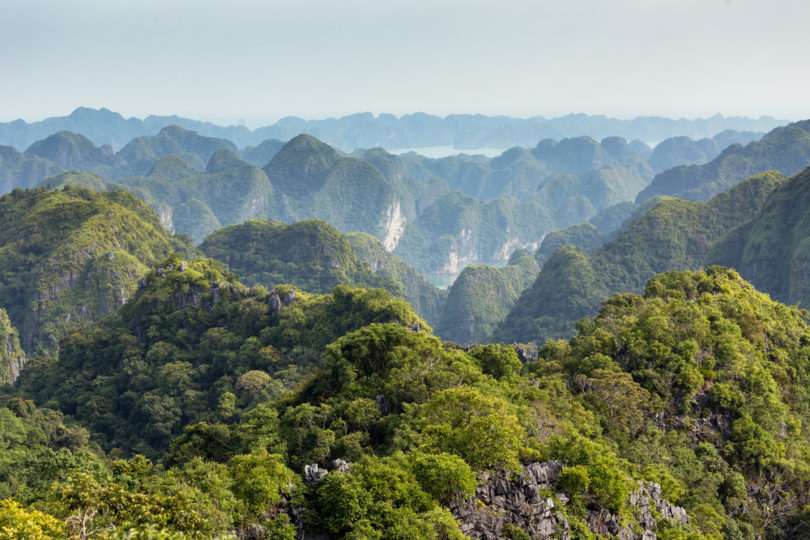 After trekking through the jungle, consider exploring more of Cat Ba Island. You can kayak in Lan Ha Bay, visit Viet Hai village to learn about local life, or simply relax at Cat Co beach. Combining these experiences will give you a complete picture of Cat Ba’s natural and cultural beauty.
After trekking through the jungle, consider exploring more of Cat Ba Island. You can kayak in Lan Ha Bay, visit Viet Hai village to learn about local life, or simply relax at Cat Co beach. Combining these experiences will give you a complete picture of Cat Ba’s natural and cultural beauty.
